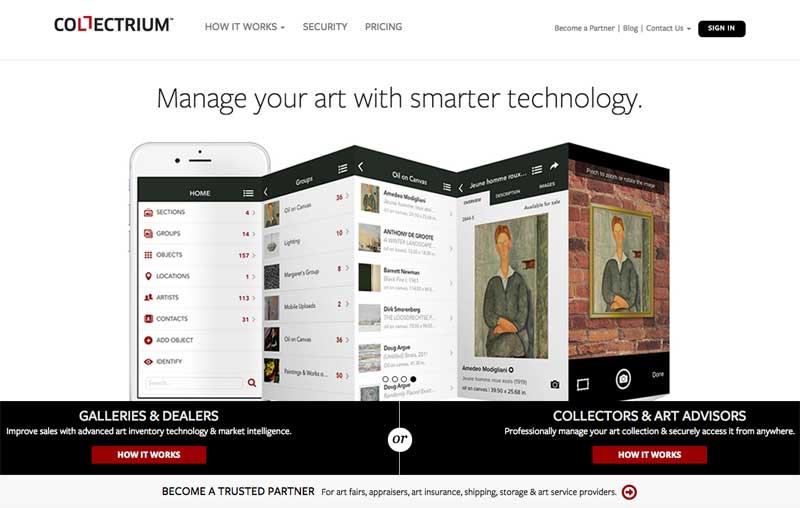Bernadine Bröcker, CEO of Vastari.com, on the future of art-tech start-ups
Last week, Christie’s announced its purchase of Collectrium, the four-year-old online art inventory system, for $16 million. Although small compared to the hundreds-of-million- and even billion-dollar deals that are commonplace in the tech industry in general, this news is ground-breaking for art-tech.
There is little precedent for tech companies showing growth within the art industry at this pace. Saatchi Art, founded in 2006 (the same year as Twitter, for your reference) had to work on eight years of development, accumulating over 45,000 artists, to sell to Demand Media for $17 million. Other big companies for art online, such as Artnet and Artprice, have been scaling up slowly before making initial public offerings (IPOs). Venture Capital funding has been invested in start-ups like Artsy, Paddle8, Auctionata and Artbinder. What all investors in the art industry’s tech companies wonder is: is the only exit for an art start-up an IPO, and will it take forever to get there? Are there big enough players looking to acquire smaller companies for their portfolios? Or should they just build strong businesses that supply the art world, without following the ‘Silicon Valley’ venture capital route?
The art world needs tech. From the London Art Startup Weekend organised by UP Global last October (when startups like Wallto and Nymphea impressed judges) to the annual Museumhack in the US, to the ‘Connect Art, Connect London’ hackathon happening later this week, it is clear that people are trying to disrupt the way we digest, purchase, share and appreciate art. Collectrium’s purchase proves there is an appetite for art-tech among key potential investors: art-world giants like Christie’s and Sotheby’s need technology to support their international empires.
This poses a question about the future of information within the art world, though. What happens to Collectrium clients’ information when purchased by a big entity like an auction house? How do we protect the collectors’ rights? Will clients leave because of the association with a commercial entity? The email Collectrium’s CEO, Boris Pevsner, sent his users to announce the sale stressed that their information would be safe – but is this enough to satisfy the uber-private collectors of the world?
Apprehension over Christie’s and Sotheby’s domination of the market exists in part because of the divide between the commercial and academic art world. People tend to question the intentions of commercial entities, and private individuals, when they collaborate with museums and non-profit organisations. The divide is getting smaller, as evidenced by many public-private initiatives worldwide – but many of these are driven by museums and collectors. Will auction houses and dealers join this conversation, and do they want to? Major tech companies such as Google are causing concern too: Google has registered its Google Art Project with its non-profit arm, hoping to be able to work with museums more freely, but is facing questions about copyright and legal issues from participating museums.
All of these issues are relevant to the new technology providers to the non-commercial art world. As private companies look to become viable businesses, they must earn money, but to work with museums they must also protect information and work within the museums’ code of ethics.
The art world is an exciting place that is changing as we speak. A recent article praises Artsy’s ‘patience’ while infiltrating the reputedly close-knit and private art-world community. Can we expect this sort of project to open the market for quicker growth and stronger exits for future art tech startups?
Let’s see what happens, but in the last few years people’s eyes have been opened to the developing opportunities, and to the potential of art tech to streamline how the art world works. Startups are enabling everything from an app to complete condition reports in half the time; to artists asking for curators’ opinions on their work; to audio guides that use QR codes to offer information in multiple languages cost-effectively; to our own startup connecting museums with collectors worldwide for exhibitions; to the digital organisation of Gertrude Stein-style events where collectors meet artists in their studios. Imagine if one company were to combine them all into one global super-art-tech-company.
This ubiquitous company is likely to develop, as has happened in other markets, but who will be behind it? And who will invest in it? Will new divides exist in the digital art world as they do in the physical one? I guess only time will tell.
Related Event
Private Goes Public: TEFAF Art Symposium
Friday 13 March, 9–11am, TEFAF Maastricht
How should the private collectors who own important treasures interact with publicly funded museums, and how will this develop in the future?
Related Articles
Shortlist: Digital Innovation of the Year (Apollo Awards 2014)
The Art of Digital: Your Paintings, Art Detective and the PCF (Andrew Ellis)
Preservation vs Presentation: is digital display a solution for museums? (Katy Barrett)
Digital Pathways: smartphone and museums (Katy Barrett)
Building the catalogue: the National Gallery and digital publishing (Caroline Campbell)



